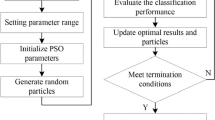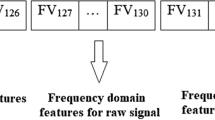Abstract
To effectively extract the fault feature information of rolling bearings and improve the performance of fault diagnosis, a fault diagnosis method based on principal component analysis and support vector machine was presented, and the rolling bearings signals with different fault states were collected. To address the limitation on effectively dealing with the raw vibration signals by the traditional signal processing technology based on Fourier transform, wavelet packet decomposition was employed to extract the features of bearing faults such as outer ring flaking, inner ring flaking, roller flaking and normal condition. Compared with the previous literature on fault diagnosis using principal component analysis (PCA) and support vector machine (SVM), one-to-one and one-to-many algorithms were taken into account. Additionally, the effect of four kernel functions, such as liner kernel function, polynomial kernel function, radial basis function and hyperbolic tangent kernel function, on the performance of SVM classifier was investigated, and the optimal hype-parameters of SVM classifier model were determined by genetic algorithm optimization. PCA was employed for dimension reduction, so as to reduce the computational complexity. The principal components that reached more than 95 % cumulative contribution rate were extracted by PCA and were input into SVM and BP neural network classifiers for identification. Results show that the fault feature dimensionality of the rolling bearing is reduced from 8-dimensions to 5-dimensions, which can still characterize the bearing status effectively, and the computational complexity is reduced as well. Compared with the raw feature set, PCA has a higher fault diagnosis accuracy (more than 97 %), and a shorter diagnosis time relatively. To better verify the superiority of the proposed method, SVM classification results were compared with the results of BP neural network. It is concluded that SVM classifier achieved a better performance than BP neural network classifier in terms of the classification accuracy and time-cost.
Similar content being viewed by others
References
X. B. Xu, Y. C. Wang and C. L. Wen, Information–fusion method for fault diagnosis based on reliability evaluation of evidence, Control Theory & Applications, 28 (4) (2011) 504–510.
L. Y. Guan, Y. M. Shao, F. S. Gu, B. Fazenda and A. Ball, Gearbox fault diagnosis under different operating conditions based on time synchronous average and ensemble empirical mode decomposition, Iccas–Sice (2009) 383–388.
M. Kang, J. Kim, L. M. Wills and J. M. Kim, Time–varying and multiresolution envelope analysis and discriminative feature analysis for bearing fault diagnosis, IEEE Transactions on Industrial Electronics, 62 (12) (2015) 7749–7761.
Y. Xu and S. Xiu, A new and effective method of bearing fault diagnosis using wavelet packet transform combined with support vector machine, J. of Computers, 6 (11) (2011) 2502–2509.
L. Meng, J. Xiang, Y. Zhong and W. Song, Fault diagnosis of rolling bearing based on second generation wavelet denoising and morphological filter, J. of Mechanical Science and Technology, 29 (8) (2015) 3121–3129.
Z. Q. Li, X. P. Yan, C. Q. Yuan and Z. X. Peng, Intelligent fault diagnosis method for marine diesel engines using instantaneous angular speed, J. of Mechanical Science and Technology, 26 (8) (2012) 2413–2423.
Z. P. Feng and M. J. Zuo, Vibration signal models for fault diagnosis of planetary gearboxes, J. of Sound and Vibration, 331 (22) (2012) 4919–4939.
Y. G. Lei, Z. J. He, J. Lin, H. Dong and D. T. Kong, Research advances of fault diagnosis technique for planetary gearboxes, J. of Mechanical Engineering, 47 (19) (2011) 59–67.
J. S. Lin and Q. Chen, Fault feature extraction of gearboxes based on multifractal detrended fluctuation analysis, J. of Vibration and Shock, 32 (2) (2013) 97–101.
W. G. Wang and L. Sun, Gearbox vibration signal fault feature extraction based on ensemble empirical mode decomposition and choi–williams distribution, Acta Armamentarii, 35 (8) (2014) 1288–1294.
Y. G. Lei, D. T. Kong, N. P. Li and J. Lin, Adaptive ensemble empirical mode decomposition and its application to fault detection of planetary gearboxes, J. of Mechanical Engineering, 50 (3) (2014) 64–70.
H. C. Peng, F. H. Long and C. Ding, Feature selection based on mutual information: Criteria of max–dependency, max–relevance, and min–redundancy, IEEE Transactions on Pattern Analysis and Machine Intelligence, 27 (8) (2005) 1226–1238.
X. Y. Zhu, Y. Y. Zhang and Y. S. Zhu, Intelligent fault diagnosis of rolling bearing based on kernel neighborhood rough sets and statistical features, J. of Mechanical Science and Technology, 26 (9) (2012) 2649–2657.
B. Otman and X. H. Yuan, Engine fault diagnosis based on multi–sensor information fusion using Dempster–Shafer evidence theory, Information Fusion, 8 (4) (2007) 379–386.
G. M. Lim, D. M. Bae and J. H. Kim, Fault diagnosis of rotating machine by thermography method on support vector machine, J. of Mechanical Science and Technology, 28 (8) (2014) 2947–2952.
Z. Q. Xing, J. F. Qu, Y. Chai, Q. Tang and Y. M. Zhou, Gear fault diagnosis under variable conditions with intrinsic timescale decomposition–singular value decomposition and support vector machine, J. of Mechanical Science and Technology, 31 (2) (2017) 545–553.
H. Z. Huang, H. K. Wang, Y. F. Li, L. Zhang and Z. Liu, Support vector machine based estimation of remaining useful life: Current research status and future trends, J. of Mechanical Science and Technology, 29 (1) (2015) 151–163.
Y. Li, W. Zhang, Q. Xiong, D. Luo, G. Mei and T. Zhang, A rolling bearing fault diagnosis strategy based on improved multiscale permutation entropy and least squares SVM, J. of Mechanical Science and Technology, 31 (6) (2017) 2711–2722.
I. A. Abu–Mahfouz, A comparative study of three artificial neural networks for the detection and classification of gear faults, International J. of General Systems, 34 (3) (2005) 261–277.
G. Niu and B. S. Yang, Intelligent condition monitoring and prognostics system based on data–fusion strategy, Expert Systems with Applications, 37 (12) (2010) 8831–8840.
H. Peng, F. Long and C. Ding, Feature selection based on mutual information: Criteria of max–dependency, maxrelevance, and min–redundancy, IEEE Transactions on Pattern Analysis and Machine Intelligence, 27 (8) (2005) 1226–1238.
X. Zhao, Data–driven fault detection, isolation and identification of rotating machinery: With applications to pumps and gearboxes, University of Alberta, Edmonton, Canada (2012).
A. Rai and S. H. Upadhyay, A review on signal processing techniques utilized in the fault diagnosis of rolling element bearings, Tribology International, 96 (2016) 289–306.
S. J. Dong, D. H. Sun, B. P. Tang, Z. Y. Gao, Y. R. Wang, W. T. Yu and M. Xia, Bearing degradation state recognition based on kernel PCA and wavelet kernel SVM, Proceedings of the Institution of Mechanical Engineers, Part C: J. of Mechanical Engineering Science, 229 (15) (2015) 2827–2834.
S. J. Dong and T. H. Luo, Bearing degradation process prediction based on the PCA and optimized LS–SVM model, Measurement, 46 (9) (2013) 3143–3152.
L. Shuang and L. Meng, Bearing fault diagnosis based on PCA and SVM, Proceedings of 2007 International Conference on Mechatronics and Automation (2007) 3503–3507.
O. R. Seryasat, H. G. Zadeh, M. Ghane, Z. Abooalizadeh, A. Taherkhani and F. Maleki, Fault diagnosis of ball–bearings using principal component analysis and support–vector machine, Life Science J., 10 (1) (2013) 393–397.
M. Li, The application of PCA and SVM in rolling bearing fault diagnosis, Advanced Materials Research, 430–432 (2012) 1163–1166.
Z. F. Li and J. G. Li, Multichannel vibration fault diagnosis for rolling bearings based on QPCA and SVM, Advanced Materials Research, 199 (200) (2011) 927–930.
Y. Zhang, Y. Qin, Z. Y. Xing, L. M. Jia and X. Q. Cheng, Roller bearing safety region estimation and state identification based on LMD–PCA–LSSVM, Measurement, 46 (3) (2013) 1315–1324.
G. F. Jia, S. F. Yuan and C. W. Tang, Fault diagnosis of roller bearing based on PCA and multi–class support vector machine, 4th IFIP International Conference on Computer and Computing Technologies in Agriculture and the 4th Symposium on Development of Rural Information (2011) 198–205.
X. Y. Yang, X. J. Zhou, W. B. Zhang and F. C. Yang, Rolling bearing fault diagnosis based on local wave method and KPCA–LSSVM, J. of Zhejiang University (Engineering Science), 44 (8) (2010) 1519–1524.
G. Tang, G. Li and H. Wang, Sparse component analysis based on support vector machine for fault diagnosis of roller bearings, International Conference on Sensing, Diagnostics, Prognostics, and Control (2017) 415–420.
F. Deng, S. Yang, Y. Liu, Y. Liao and B. Ren, Fault diagnosis of rolling bearing using the hermitian wavelet analysis, KPCA and SVM, International Conference on Sensing, Diagnostics, Prognostics, and Control, IEEE (2017) 632–637.
M. F. M. Yusof, C. K. E. Nizwan, S. A. Ong and M. Q. M. Ridzuan, Clustering of frequency spectrums from different bearing fault using principle component analysis, MATEC Web of Conferences, 90 (2017) 01006.
Y. J. Cheng, H. Yuan, H. M. Liu and C. Lu, Fault diagnosis for rolling bearing based on SIFT–KPCA and SVM, Engineering Computations, 34 (1) (2017) 53–65.
C. Wang, L. M. Jia and X. F. Li, Fault diagnosis method for the train axle box bearing based on KPCA and GA–SVM, Applied Mechanics & Materials, 441 (2014) 376–379.
S. Nimityongskul and D. C. Kammer, Frequency domain model reduction based on principal component analysis, Mechanical Systems & Signal Processing, 24 (1) (2010) 41–51.
Y. K. Gu, Z. X. Cheng and F. L. Zhu, Rolling bearing fault feature fusion based on principal component analysis and support vector machine, China Mechanical Engineering, 26 (20) (2015) 2778–2783.
X. Zhang, W. Lei and L. I. Bing, Bearing fault detection and diagnosis method based on principal component analysis and hidden markov model, J. of Xian Jiaotong University, 51 (6) (2017) 1–7.
Author information
Authors and Affiliations
Corresponding author
Additional information
This paper was presented at ICMR 2017 & QR2MSE 2017, Crowne Plaza Chengdu West, Chengdu, China, October 24–27, 2017. Recommended by Guest Editor Dong Ho Bae.
Ying-Kui Gu is a Professor of the School of Mechanical and Electrical Engineering, at Jiangxi University of Science and Technology. He received a Ph.D. in Mechanical Engineering from Dalian University of Technology in 2005. His research interests include reliability engineering, optimization design, and product development.
Xiao-Qing Zhou is currently an M.S. candidate in Mechanical Engineering at Jiangxi University of Science and Technology. He received his B.S. in Industrial Engineering from Jiangxi University of Science and Technology in 2016. His research interests include reliability engineering and fault diagnosis.
Dong-Ping Yu is currently an M.S. candidate in Mechanical Engineering at Jiangxi University of Science and Technology. He received his B.S. in Mechanical Engineering from Jiangxi University of Science and Technology in 2015. His research interests include reliability engineering and fault diagnosis.
Yan-Jun Shen is currently an M.S. candidate in Mechanical Engineering at Jiangxi University of Science and Technology. He received his B.S. in Mechanical Engineering from China University of Geosciences in 2015. His research interests include reliability engineering and fault diagnosis.
Rights and permissions
About this article
Cite this article
Gu, YK., Zhou, XQ., Yu, DP. et al. Fault diagnosis method of rolling bearing using principal component analysis and support vector machine. J Mech Sci Technol 32, 5079–5088 (2018). https://doi.org/10.1007/s12206-018-1004-0
Received:
Revised:
Accepted:
Published:
Issue Date:
DOI: https://doi.org/10.1007/s12206-018-1004-0




